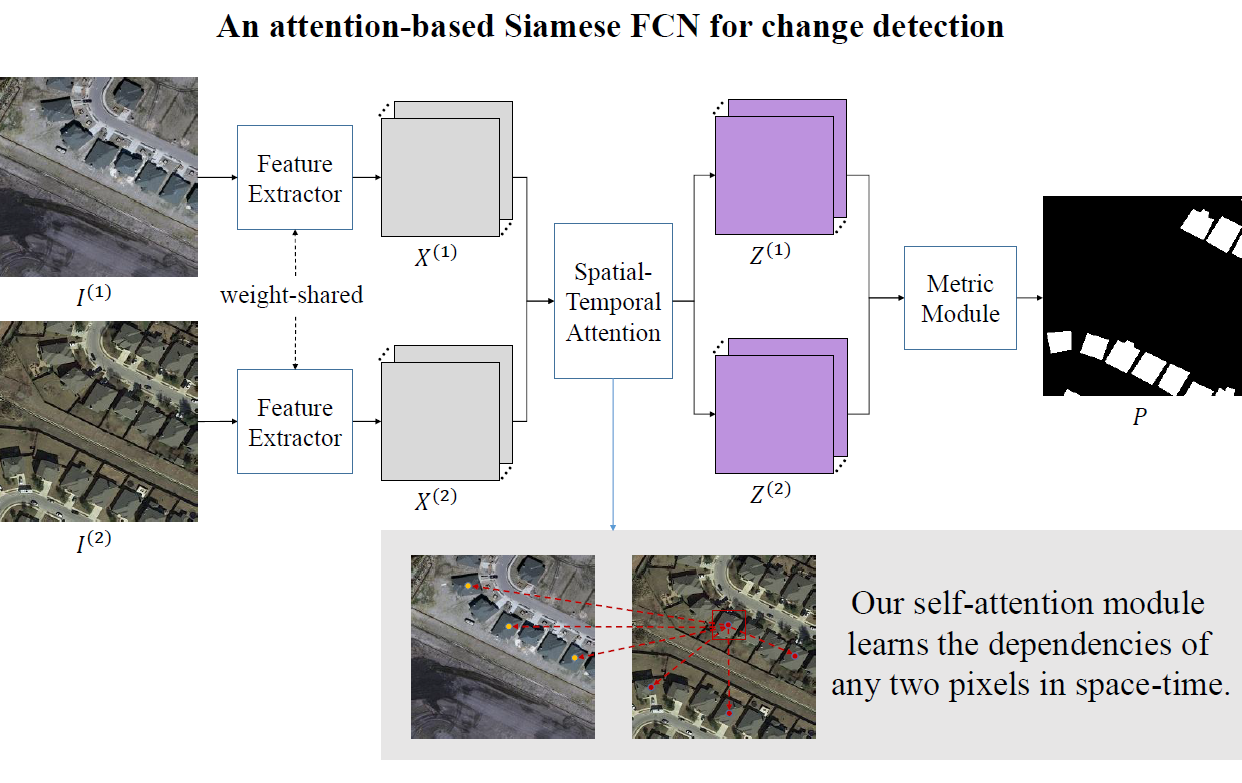justchenhao / Stanet
Programming Languages
Projects that are alternatives of or similar to Stanet
STANet for remote sensing image change detection
It is the implementation of the paper: A Spatial-Temporal Attention-Based Method and a New Dataset for Remote Sensing Image Change Detection.
Here, we provide the pytorch implementation of the spatial-temporal attention neural network (STANet) for remote sensing image change detection.
Change log
20210112:
- add the pretraining weight of PAM. baidupan link, code: 2rja
20201105:
- add a demo for quick start.
- add more dataset loader modes.
- enhance the image augmentation module (crop and rotation).
20200601:
- first commit
Prerequisites
- windows or Linux
- Python 3.6+
- CPU or NVIDIA GPU
- CUDA 9.0+
- PyTorch > 1.0
- visdom
Installation
Clone this repo:
git clone https://github.com/justchenhao/STANet
cd STANet
Install PyTorch 1.0+ and other dependencies (e.g., torchvision, visdom and dominate)
Quick Start
You can run a demo to get started.
python demo.py
The input samples are in samples. After successfully run this script, you can find the predicted results in samples/output.
Prepare Datasets
download the change detection dataset
You could download the LEVIR-CD at https://justchenhao.github.io/LEVIR/;
The path list in the downloaded folder is as follows:
path to LEVIR-CD:
├─train
│ ├─A
│ ├─B
│ ├─label
├─val
│ ├─A
│ ├─B
│ ├─label
├─test
│ ├─A
│ ├─B
│ ├─label
where A contains images of pre-phase, B contains images of post-phase, and label contains label maps.
cut bitemporal image pairs
The original image in LEVIR-CD has a size of 1024 * 1024, which will consume too much memory when training. Therefore, we can cut the origin images into smaller patches (e.g., 256 * 256, or 512 * 512). In our paper, we cut the original image into patches of 256 * 256 size without overlapping.
Make sure that the corresponding patch samples in the A, B, and label subfolders have the same name.
Train
Monitor training status
To view training results and loss plots, run this script and click the URL http://localhost:8097.
python -m visdom.server
train with our base method
Run the following script:
python ./train.py --save_epoch_freq 1 --angle 15 --dataroot path-to-LEVIR-CD-train --val_dataroot path-to-LEVIR-CD-val --name LEVIR-CDF0 --lr 0.001 --model CDF0 --batch_size 8 --load_size 256 --crop_size 256 --preprocess rotate_and_crop
Once finished, you could find the best model and the log files in the project folder.
train with Basic spatial-temporal Attention Module (BAM) method
python ./train.py --save_epoch_freq 1 --angle 15 --dataroot path-to-LEVIR-CD-train --val_dataroot path-to-LEVIR-CD-val --name LEVIR-CDFA0 --lr 0.001 --model CDFA --SA_mode BAM --batch_size 8 --load_size 256 --crop_size 256 --preprocess rotate_and_crop
train with Pyramid spatial-temporal Attention Module (PAM) method
python ./train.py --save_epoch_freq 1 --angle 15 --dataroot path-to-LEVIR-CD-train --val_dataroot path-to-LEVIR-CD-val --name LEVIR-CDFAp0 --lr 0.001 --model --SA_mode PAM CDFA --batch_size 8 --load_size 256 --crop_size 256 --preprocess rotate_and_crop
Test
You could edit the file val.py, for example:
if __name__ == '__main__':
opt = TestOptions().parse() # get training options
opt = make_val_opt(opt)
opt.phase = 'test'
opt.dataroot = 'path-to-LEVIR-CD-test' # data root
opt.dataset_mode = 'changedetection'
opt.n_class = 2
opt.SA_mode = 'PAM' # BAM | PAM
opt.arch = 'mynet3'
opt.model = 'CDFA' # model type
opt.name = 'LEVIR-CDFAp0' # project name
opt.results_dir = './results/' # save predicted images
opt.epoch = 'best-epoch-in-val' # which epoch to test
opt.num_test = np.inf
val(opt)
then run the script: python val.py. Once finished, you can find the prediction log file in the project directory and predicted image files in the result directory.
Using other dataset mode
List mode
list=train
lr=0.001
dataset_mode=list
dataroot=path-to-dataroot
name=project_name
python ./train.py --num_threads 4 --display_id 0 --dataroot ${dataroot} --val_dataroot ${dataroot} --save_epoch_freq 1 --niter 100 --angle 15 --niter_decay 100 --display_env FAp0 --SA_mode PAM --name $name --lr $lr --model CDFA --batch_size 4 --dataset_mode $dataset_mode --val_dataset_mode $dataset_mode --split $list --load_size 256 --crop_size 256 --preprocess resize_rotate_and_crop
In this case, the data structure should be the following:
"""
data structure
-dataroot
├─A
├─train1.png
...
├─B
├─train1.png
...
├─label
├─train1.png
...
└─list
├─val.txt
├─test.txt
└─train.txt
# In list/train.txt, each low writes the filename of each sample,
# for example:
list/train.txt
train1.png
train2.png
...
"""
Concat mode for loading multiple datasets (each default mode is List)
list=train
lr=0.001
dataset_type=CD_data1,CD_data2,...,
val_dataset_type=CD_data
dataset_mode=concat
name=project_name
python ./train.py --num_threads 4 --display_id 0 --dataset_type $dataset_type --val_dataset_type $val_dataset_type --save_epoch_freq 1 --niter 100 --angle 15 --niter_decay 100 --display_env FAp0 --SA_mode PAM --name $name --lr $lr --model CDFA --batch_size 4 --dataset_mode $dataset_mode --val_dataset_mode $dataset_mode --split $list --load_size 256 --crop_size 256 --preprocess resize_rotate_and_crop
Note, in this case, you should modify the get_dataset_info in data/data_config.py to add the corresponding dataset_name and dataroot in it.
if dataset_type == 'LEVIR_CD':
root = 'path-to-LEVIR_CD-dataroot'
elif ...
# add more dataset ...
Other TIPS
For more Training/Testing guides, you could see the option files in the ./options/ folder.
Citation
If you use this code for your research, please cite our papers.
@Article{rs12101662,
AUTHOR = {Chen, Hao and Shi, Zhenwei},
TITLE = {A Spatial-Temporal Attention-Based Method and a New Dataset for Remote Sensing Image Change Detection},
JOURNAL = {Remote Sensing},
VOLUME = {12},
YEAR = {2020},
NUMBER = {10},
ARTICLE-NUMBER = {1662},
URL = {https://www.mdpi.com/2072-4292/12/10/1662},
ISSN = {2072-4292},
DOI = {10.3390/rs12101662}
}
Acknowledgments
Our code is inspired by pytorch-CycleGAN.

